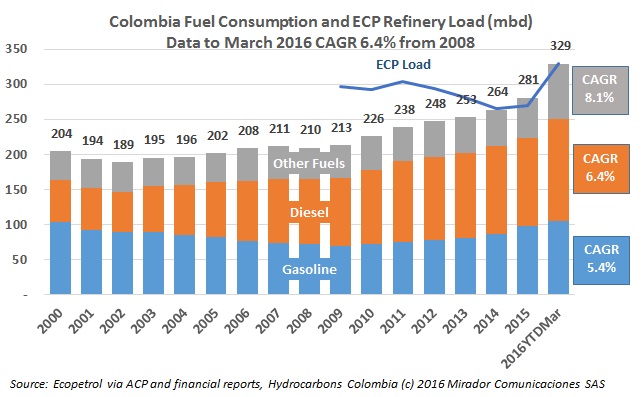Colombia and Peru have received more interest from foreign investors as traditional markets like Brazil and Mexico have been hampered by economic problems. But despite this positive news, Latin America still ranks low as a priority for global investors, according to a recent survey.
The constant decline of existing gas fields like those in La Guajira, and a lack of new sources has spelled the end to an expansion of thermal generation plants designed to back up the general electrical grid.
In light of the reopening of the Venezuela-Colombia border, the Minister of Finance (MinHacienda) Mauricio Cárdenas said that more must be done in Venezuela to prevent the entry of contraband fuel, which brings negative social consequences.

Yet another reader question and yet another off-the-cuff answer led to some introspection and some inspection of the facts. Fuel consumption – as measured by Ecopetrol (NYSE:EC) – has grown by 6.4% annually since 2008.
The president of the association of fuel stations Fedispetrol Álvaro Younes said that contrary to what the government’s formula has yielded, fuel prices for both gasoline and diesel should be falling, and be at least CoP$300-400 (US$0.09-0.12) less per gallon.
A report from the United Nations Development Program (UNDP) said that the government has been able to avoid the worst consequences of a fall in oil prices, but that with a price of US$60/barrel there are worrying signs for the midterm future.

For the first time in several months, the Ministry of Mines and Energy (MinMinas) has announced a change in fuel prices for the month of August: gasoline will rise slightly while diesel will fall, which the ministry says is a result of biofuels costs.

There is much said in the press about Colombia’s cost of fuel, most of it alleging a high drain on Colombian wallets. But a comparison of the costs in other Latin American countries show that it is far from being one of the most expensive countries.
Ecopetrol (NYSE:EC) through its subsidiary Ecodiesel, has helped create 10,000 jobs and cleaner biofuels in Barrancabermeja thanks to an alliance with different palm oil firms in the Middle Magdalena.
Following accusations from the retail fuel station association Fendipetróleo that Terpel is taking advantage of its status as a wholesaler and retailer of fuel to crush small businesses with an unfair advantage and low prices, the firm’s president Sylvia Escovar responded.